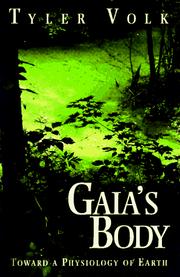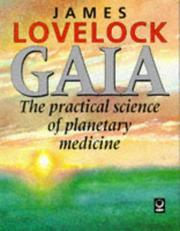| Listing 11 - 13 of 13 | << page >> |
Sort by
|

ISBN: 0387982701 1461274524 1461221900 Year: 1998 Publisher: New York (N.Y.) : Copernicus,
Abstract | Keywords | Export | Availability | Bookmark
 Loading...
Loading...Choose an application
- Reference Manager
- EndNote
- RefWorks (Direct export to RefWorks)
Is Earth alive? Put more rigorously, is the biosphere a self- sustaining meta-organism? This is the essence of Gaia theory: if the biosphere really is a single coherent system, then it must have something like a physiology. It must have systems and processes that perform living functions. OK, then, what systems, what processes, what functions? Gaia's Body is Tyler Volk's answer to this question. In this book, he describes the environment that enables the biosphere to exist; various ways of looking at its "anatomy" and "physiology," the major biogeographical regions such as rainforests, deserts, and tundra; the major substances the biosphere is made of; and the chemical cycles that keep it in balance. He then looks at the question of whether there are any long-term trends in earth's evolution--is Gaia growing colder? more complex?--and examines the role of humanity in Gaia's past and future. Adherents and skeptics both have often been concerned that Gaia theory contains too much goddess and too few testable hypotheses. This is the book that describes, for scientists, students, and lay readers alike, the theory's firm basis in science.
Cosmology --- General ecology and biosociology --- Solar system --- Gaia hypothesis. --- Gaia hypothesis --- Gaia concept --- Gaia principle --- Gaia theory --- Gaian hypothesis --- Living earth theory --- Ecology --- Geobiology --- Biosphere --- Philosophy --- Earth sciences. --- Geoecology. --- Environmental geology. --- Nature conservation. --- Ecology . --- Earth Sciences, general. --- Geoecology/Natural Processes. --- Nature Conservation. --- Ecology. --- Balance of nature --- Biology --- Bionomics --- Ecological processes --- Ecological science --- Ecological sciences --- Environment --- Environmental biology --- Oecology --- Environmental sciences --- Population biology --- Conservation of nature --- Nature --- Nature protection --- Protection of nature --- Conservation of natural resources --- Applied ecology --- Conservation biology --- Endangered ecosystems --- Natural areas --- Geoecology --- Environmental protection --- Physical geology --- Geosciences --- Physical sciences --- Conservation

ISBN: 185675040X 9781856750400 Year: 1991 Publisher: London Gaia book
Abstract | Keywords | Export | Availability | Bookmark
 Loading...
Loading...Choose an application
- Reference Manager
- EndNote
- RefWorks (Direct export to RefWorks)
550.7 --- #Hist.Geol. --- 550.7 Geobiology. Geological actions of organisms --- Geobiology. Geological actions of organisms --- Biosphere --- Ecology --- Environmental protection --- Gaia hypothesis --- Geobiology --- Nature --- #Hist.Geol --- Anthropogenic effects on nature --- Ecological footprint --- Human beings --- Anthropogenic soils --- Human ecology --- Gaia concept --- Gaia principle --- Gaia theory --- Gaian hypothesis --- Living earth theory --- Environmental quality management --- Protection of environment --- Environmental sciences --- Applied ecology --- Environmental engineering --- Environmental policy --- Environmental quality --- Ecophilosophy --- Life (Biology) --- Planets --- Philosophy --- Effect of human beings on --- Biosphere. --- Environmental protection. --- Gaia hypothesis. --- Philosophy. --- Effect of human beings on.
Book
ISBN: 9780691145143 9780691145136 0691145148 069114513X 128300917X 9786613009173 1400839114 9781400839117 Year: 2011 Publisher: Princeton, NJ
Abstract | Keywords | Export | Availability | Bookmark
 Loading...
Loading...Choose an application
- Reference Manager
- EndNote
- RefWorks (Direct export to RefWorks)
Mathematical Modeling of Earth's Dynamical Systems gives earth scientists the essential skills for translating chemical and physical systems into mathematical and computational models that provide enhanced insight into Earth's processes. Using a step-by-step method, the book identifies the important geological variables of physical-chemical geoscience problems and describes the mechanisms that control these variables. This book is directed toward upper-level undergraduate students, graduate students, researchers, and professionals who want to learn how to abstract complex systems into sets of dynamic equations. It shows students how to reorganize domains of interest and key factors, and how to explain assumptions in formal terms. The book reveals what data best tests ideas of how nature works, and cautions against inadequate transport laws, unconstrainec coeffecients, and unfalsifiable models. Studentr using this text should be familiar with the principles of physics, chemistry, and geology, and have taken a year of differential and integral calculus. -- BACK COVER
Gaia hypothesis --- 551.24 --- 551.24 Geotectonics. Crust movements. Tectonic structures and their elements.Faults.Folds. Uplift. Subsidence. Compression. Tectogenesis. Orogenesis. --- Geotectonics. Crust movements. Tectonic structures and their elements.Faults.Folds. Uplift. Subsidence. Compression. Tectogenesis. Orogenesis. --- Gaia concept --- Gaia principle --- Gaia theory --- Gaian hypothesis --- Living earth theory --- Ecology --- Geobiology --- Biosphere --- Mathematical models. --- Philosophy --- Hypothèse Gaïa --- Mathematical models --- Modèles mathématiques --- Gaia hypothesis - Mathematical models. --- Gaia hypothesis --Mathematical models. --- Geobiology. --- Biology --- Earth sciences --- Geotectonics. Crust movements. Tectonic structures and their elements.Faults.Folds. Uplift. Subsidence. Compression. Tectogenesis. Orogenesis
| Listing 11 - 13 of 13 | << page >> |
Sort by
|

 Search
Search Feedback
Feedback About UniCat
About UniCat  Help
Help News
News